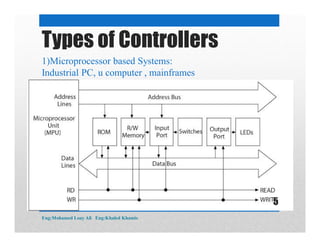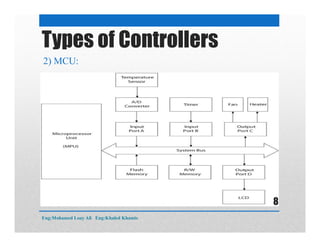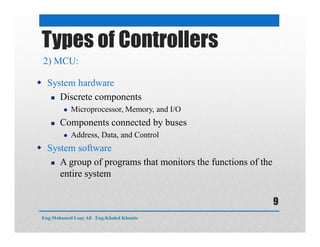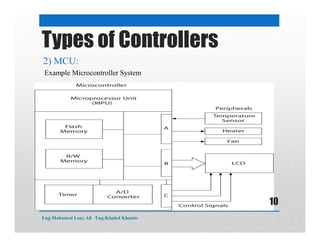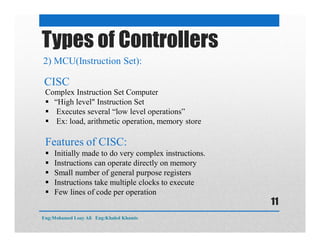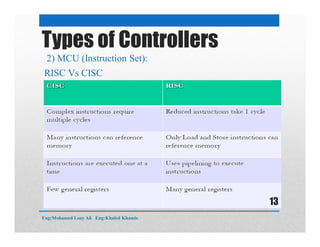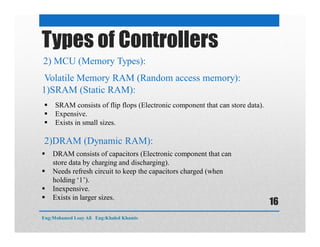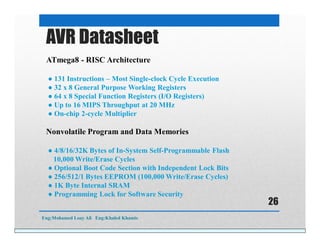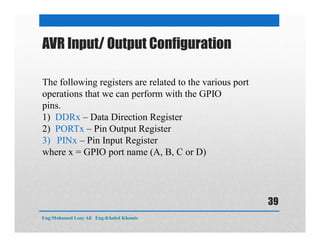AVR_Course_Day4 introduction to microcontroller
- 1. Introduction to Microcontroller Eng:Mohamed Loay Ali Eng:Khaled Khamis 1
- 2. Contents • Types of Controllers. • Types of Compilers. • AVR DataSheet. • AVR input/output Configuration. • Writing First Code in AVR. • Transfer First Program to AVR. • Switch Debouncing (Case Study). Eng:Mohamed Loay Ali Eng:Khaled Khamis 2
- 3. Types of Controllers 1)Microprocessor based Systems: Industrial PC, u computer , mainframes Eng:Mohamed Loay Ali Eng:Khaled Khamis 3
- 4. Types of Controllers 1)Microprocessor based Systems: Industrial PC, u computer , mainframes Microprocessor (CPU). Eng:Mohamed Loay Ali Eng:Khaled Khamis 4
- 5. Types of Controllers 1)Microprocessor based Systems: Industrial PC, u computer , mainframes Microprocessor Architecture: Eng:Mohamed Loay Ali Eng:Khaled Khamis 5
- 6. Types of Controllers 1)Microprocessor based Systems: Industrial PC, u computer , mainframes The MPU communicates with Memory and I/O using the System Bus Address bus Unidirectional Memory and I/O Addresses Data bus Bidirectional Transfers Binary Data and Instructions Control lines Read and Write timing signals Eng:Mohamed Loay Ali Eng:Khaled Khamis 6
- 7. Example Microprocessor System Types of Controllers 1)Microprocessor based Systems: Industrial PC, u computer , mainframes Eng:Mohamed Loay Ali Eng:Khaled Khamis 7
- 8. Types of Controllers 2) MCU: Eng:Mohamed Loay Ali Eng:Khaled Khamis 8
- 9. Types of Controllers 2) MCU: System hardware Discrete components Microprocessor, Memory, and I/O Components connected by buses Address, Data, and Control System software A group of programs that monitors the functions of the entire system Eng:Mohamed Loay Ali Eng:Khaled Khamis 9
- 10. Types of Controllers 2) MCU: Example Microcontroller System Eng:Mohamed Loay Ali Eng:Khaled Khamis 10
- 11. CISC Complex Instruction Set Computer “High level" Instruction Set Executes several “low level operations” Ex: load, arithmetic operation, memory store Features of CISC: Initially made to do very complex instructions. Instructions can operate directly on memory Small number of general purpose registers Instructions take multiple clocks to execute Few lines of code per operation Types of Controllers 2) MCU(Instruction Set): Eng:Mohamed Loay Ali Eng:Khaled Khamis 11
- 12. RISC Reduced Instruction Set Computer RISC is a CPU design that recognizes only a limited number of instructions Simple instructions Instructions are executed quickly Features of RISC: Found to be more efficient in computing very complex instructions by using many of very short and simple instructions. Executes a series of simple instruction instead of a complex instruction Instructions are executed within one clock cycle. Incorporates a large number of general registers for arithmetic operations to avoid storing variables on a stack in memory. Only the load and store instructions operate directly onto memory. Types of Controllers 2) MCU (Instruction Set): Eng:Mohamed Loay Ali Eng:Khaled Khamis 12
- 13. RISC Vs CISC Types of Controllers 2) MCU (Instruction Set): Eng:Mohamed Loay Ali Eng:Khaled Khamis 13
- 14. Register File: A (usually) relatively small memory embedded on the CPU. It is used as a scratchpad for temporary storage of values the CPU is working with you could call it the CPU’s short term memory. Data Memory: For longer term storage, generic CPUs usually employ an external memory which is much larger than the register file. Data that is stored there may be short-lived, but may also be valid for as long as the CPU is running Instruction Memory: Like the data memory, the instruction memory is usually a relatively large external memory (at least with general CPUs) Types of Controllers 2) MCU(Memory Types): Eng:Mohamed Loay Ali Eng:Khaled Khamis 14
- 15. Types of Controllers 2) MCU (Memory Types): Eng:Mohamed Loay Ali Eng:Khaled Khamis 15
- 16. Volatile Memory RAM (Random access memory): 1)SRAM (Static RAM): SRAM consists of flip flops (Electronic component that can store data). Expensive. Exists in small sizes. DRAM consists of capacitors (Electronic component that can store data by charging and discharging). Needs refresh circuit to keep the capacitors charged (when holding ‘1’). Inexpensive. Exists in larger sizes. 2)DRAM (Dynamic RAM): Types of Controllers 2) MCU (Memory Types): Eng:Mohamed Loay Ali Eng:Khaled Khamis 16
- 17. Non Volatile memories ROM (Read only memory): PROM (Programmable ROM ) 1- One time programmable (OTP). 2- Used to protect the data that can’t be erased and rewritten. EPROM (Erasable PROM) 1. Multi-time programmable. 2. Can be erased using UV (Ultraviolet) rays from the sun. 3. Needs long time to be erased (about 20 minutes). Types of Controllers 2) MCU (Memory Types): Eng:Mohamed Loay Ali Eng:Khaled Khamis 17
- 18. EEPROM (Electrically EPROM) 1. Multi-time programmable. 2. Can be erased using Electricity (from PC). 3. Needs short time to be erased (few milliseconds). Flash EEPROM 1. Multi-time programmable. 2. Can be erased using Electricity (from PC). 3. Needs very short time to be erased (few microseconds). Types of Controllers 2) MCU (Memory Types): Eng:Mohamed Loay Ali Eng:Khaled Khamis 18
- 19. Types of Controllers 2) MCU (Memories Located in MCUS): Eng:Mohamed Loay Ali Eng:Khaled Khamis 19
- 20. Types of Controllers 2) MCU (Registers in MCUS): The memory in which the microcontroller stored data during the execution of the program. Classified into two types: 1. General purpose registers. There are 30 General purpose registers in microcontrollers rages from R1 to R31. Any variables are declared in the program are stored in this registers, like the variables of mathematical operations. 2. Special function registers. • Special function registers are registers defined by the manufacturer of the microcontroller itself to give an access to the features of microcontroller like Timer, SPI, UART, ADC, IO ports and external interrupt modules. • Ex: DDRA: determine the state of this port I/p or O/p PORTA: determine if the port generate logic 1 or 0. Eng:Mohamed Loay Ali Eng:Khaled Khamis 20
- 21. Types of Controllers 2) MCU (Comparison between Different types of MCUs): Eng:Mohamed Loay Ali Eng:Khaled Khamis 21
- 22. Types of Controllers 3)DSP (Digital Signal Processor): Advantages of DSP Conventional DSP devices are well-suited to a wide range of applications requiring mathematical processing power. This arises from the high-speed DSP cores of the devices and a number of architectural features. DSPs typically support a single-cycle multiply-accumulate function, crucial to efficient DSP algorithm implementations. Disadvantages of DSP: Not Suitable for application requiring Computaional processing power and interrupts. Doesn’t include automotive communication module (CAN,LIN). Very Expensive Compared with MCU. Eng:Mohamed Loay Ali Eng:Khaled Khamis 22
- 23. Types of Controllers 3)DSC (Digital Signal Controller): DSC series of devices specifically addresses two main application requirement areas. First, computational requirements associated with complex control algorithms are met by a high-speed core, capable of executing up to 40 million multiply-accumulate operations per second. Second, control system interface requirements are met by a rich integrated peripheral set, including PWM capability, analog-to-digital conversion, bit I/O, and multiple serial interfaces. Examples: 1) The 56F800 DSC series (Free Scale). 2)The Lm4f123 DSC (Texas Instruments) Eng:Mohamed Loay Ali Eng:Khaled Khamis 23
- 24. Types of Compilers 1) Atemel Studio (GCC Compiler): The GNU Compiler Collection (GCC) is a compiler system produced by the GNU Project supporting various programming languages. GCC is a key component of the GNU toolchain. The Free Software Foundation (FSF) distributes GCC under the GNU General Public License (GNU GPL) GCC target processor families as of version 4.3 include: Alpha,ARM,AVR,Blackfin,H8/300,HC12,IA-32 (x86),IA-64,MIPS,Motorola 68000,PA-RISC,PDP-11,PowerPC,R8C / M16C / M32C,SPARC,SPU,SuperH System/390 / zSeriesVAX,x86-64 Eng:Mohamed Loay Ali Eng:Khaled Khamis 24
- 25. Types of Compilers 2)CodeVision: Is the only integrated development environment on the market that features an automatic program generator for AVR Family. It targets only the AVR Processor. Eng:Mohamed Loay Ali Eng:Khaled Khamis 25
- 26. ATmega8 - RISC Architecture ● 131 Instructions – Most Single-clock Cycle Execution ● 32 x 8 General Purpose Working Registers ● 64 x 8 Special Function Registers (I/O Registers) ● Up to 16 MIPS Throughput at 20 MHz ● On-chip 2-cycle Multiplier Nonvolatile Program and Data Memories ● 4/8/16/32K Bytes of In-System Self-Programmable Flash 10,000 Write/Erase Cycles ● Optional Boot Code Section with Independent Lock Bits ● 256/512/1 Bytes EEPROM (100,000 Write/Erase Cycles) ● 1K Byte Internal SRAM ● Programming Lock for Software Security AVR Datasheet Eng:Mohamed Loay Ali Eng:Khaled Khamis 26
- 27. Peripheral Features ● Two 8-bit Timer/Counters ● One 16-bit Timer/Counter with Capture Mode ● Real Time Counter with Separate Oscillator ● 6 PWM Channels ● 8-channel ADC with 10 resp 8 Bit resolution (TQFP: 8 channels) ● Two-wire Serial Interface (TWI) ● Programmable Serial USART ● Master/Slave SPI Serial Interface ● Programmable Watchdog Timer with On-chip Oscillator ● On-chip Analog Comparator AVR Datasheet Eng:Mohamed Loay Ali Eng:Khaled Khamis 27
- 28. Special Microcontroller Features ● Programmable Brown-out Detection ● Internal Calibrated RC Oscillator ● External and Internal Interrupt Sources ● 6 Sleep Modes I/O and Packages ● 23 Programmable I/O Lines ● 28-lead PDIP, 32-lead TQFP, and 32-pad MLF AVR Datasheet Eng:Mohamed Loay Ali Eng:Khaled Khamis 28
- 29. Operating Voltages 1.8v to 5.5v Speed Grades 0 - [email protected] - 5.5V, 0 - [email protected] - 5.5.V, 0 - 20MHz @ 4.5 - 5.5V Power Consumption at 4 Mhz, 3V, 25°C ● Active: 0.2 mA ● Idle Mode: 0.1uA ● Power-down Mode: 0.1 μA AVR Datasheet Eng:Mohamed Loay Ali Eng:Khaled Khamis 29
- 30. AVR Pin Configuration (Atmega328) AVR Datasheet Eng:Mohamed Loay Ali Eng:Khaled Khamis 30
- 31. Pin and Port Overview: GND: Ground (0V) VCC: Digital Supply Voltage (2,7 – 5,5V) AVCC: Analog Supply Voltage connect to low-pass filtered VCC AREF: Analog Reference Voltage, usually AVCC / Reset: Low level on this pin will generate a reset Port B, Port C, Port D: General Purpose 8 Bit bidirectional I/O - Ports, optional internal pullup-resistors when configured as input output source capability: 20mA Special Functions of the Ports available as configured using the SFRs: Port D: Uart, external Interrupts, Analog Comparator Port B: External Oscillator/Crystal, SPI Port C: A/D converters, TWI AVR Datasheet Eng:Mohamed Loay Ali Eng:Khaled Khamis 31
- 32. AVR Block Diagram (Atmega328) AVR Datasheet Eng:Mohamed Loay Ali Eng:Khaled Khamis 32
- 33. AVR Datasheet AVR Circuit (Atmega328) Eng:Mohamed Loay Ali Eng:Khaled Khamis 33
- 34. AVR Datasheet AVR Circuit Components (Atmega328) 1) Atemga328. 2) Crystal Oscillator 16 MHz 3) 2 Capacitor 22 pf. 4) 10 Kilo ohm Resistor. 5) Press Switch. 6) Power Supply 5V Eng:Mohamed Loay Ali Eng:Khaled Khamis 34
- 35. AVR Datasheet AVR Clock Systems Eng:Mohamed Loay Ali Eng:Khaled Khamis 35
- 36. ● Clock Muliplexer selects the clock source according to FUSE settings ● Clock Control Unit distributes clocks clocks can be halted to reduce power consumption ● CPU Clock: CPU, ALU, GPRs ● I/O Clock: Ports, Timers, SPI, UART ● ADC Clock: seperate cock for ADC noise reduction in sleep mode ● Asynchronous Timer Clock: external 32kHz Crystal for realtime clock, keeps timer module running during sleep mode AVR Datasheet AVR Clock Systems(options) Eng:Mohamed Loay Ali Eng:Khaled Khamis 36
- 37. ● The four CKSEL Bits of the FUSE – Byte select the main Clock Source ● The startup time to stabilize power supply and oscillator can be changed with the SUT fuses ● The device is shipped with internal RC oscillator at 8.0MHz and with the fuse CKDIV8 programmed, resulting in 1.0MHz system clock. AVR Datasheet AVR Clock Systems(Fuse Bits) Eng:Mohamed Loay Ali Eng:Khaled Khamis 37
- 38. AVR Datasheet AVR Clock Systems(Using External Crystal) Eng:Mohamed Loay Ali Eng:Khaled Khamis 38
- 39. AVR Input/ Output Configuration The following registers are related to the various port operations that we can perform with the GPIO pins. 1) DDRx – Data Direction Register 2) PORTx – Pin Output Register 3) PINx – Pin Input Register where x = GPIO port name (A, B, C or D) Eng:Mohamed Loay Ali Eng:Khaled Khamis 39
- 40. AVR Input/ Output Configuration Eng:Mohamed Loay Ali Eng:Khaled Khamis 40
- 41. AVR Input/ Output Configuration Eng:Mohamed Loay Ali Eng:Khaled Khamis 41
- 42. AVR Input/ Output Configuration DDRX Registers: DDRx initializes the port shown in the following figure DDRC = 0b10110001; DDRC = 0xB1; //suitable to define all pins of the port DDRC = (1<<0)|(1<<4)|(1<<5)|(1<<7); DDRC|= (1<<PINC0)| (1<<PINC4) |(1<<PINC5) |(1<<PINC7);//using bitwise suitable to define one pin Eng:Mohamed Loay Ali Eng:Khaled Khamis 42
- 43. AVR Input/ Output Configuration PORTx Register: The PORTx register determines whether the output should be HIGH or LOW of the pins. DDRx initializes the port shown in the following figure. Examples of setting the output PORTD = 0b01001001; PORTD = 0x49; //suitable to define all pins of the port. PORTD = (1 << 0)|(1 << 3)|(1 << 6); PORTD|=(1<<PIND0) | (1<<PIND3) |(1<<PIND6);// using bitwise suitable to define one pin. Eng:Mohamed Loay Ali Eng:Khaled Khamis 43
- 44. AVR Input/ Output Configuration PINx Register: The PINx register gets the reading from the input pins of the MCU. The register goes as follows: Examples of setting the input DDRC = 0b10110001; PINC = 0b01001011; Eng:Mohamed Loay Ali Eng:Khaled Khamis 44
- 45. Writing First Code in AVR See the Appendix For information about Atmel Studio Also, See the following Example (Led Blinking, Adding Button). Eng:Mohamed Loay Ali Eng:Khaled Khamis 45
- 46. Transfer First Program to AVR The following programs are used to download the program (Hex file): 1. Khazama 2. Extreme Burner 3. AVR Burn – O - Mat Transfer the Program to AVR: Eng:Mohamed Loay Ali Eng:Khaled Khamis 46
- 47. Switch Debouncing The Problem: Eng:Mohamed Loay Ali Eng:Khaled Khamis 47
- 48. Switch Debouncing The Solution by Hardware: Eng:Mohamed Loay Ali Eng:Khaled Khamis 48





